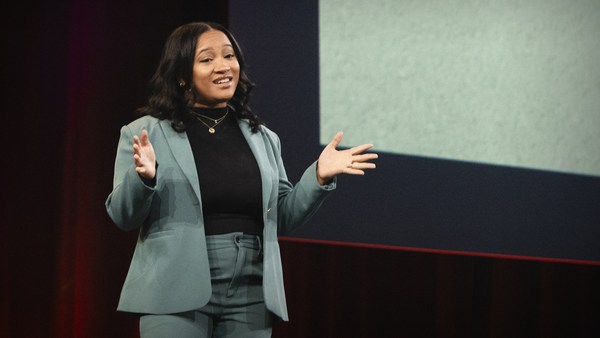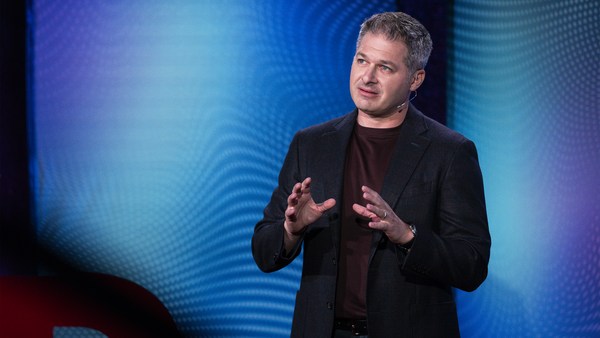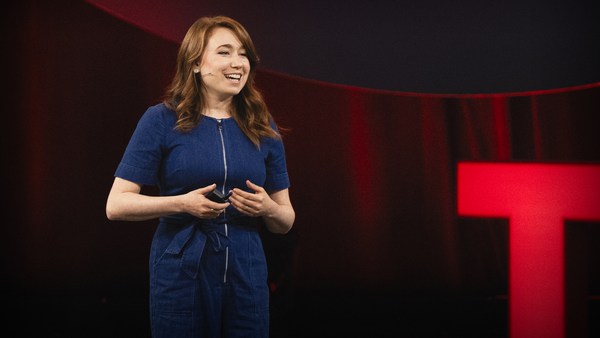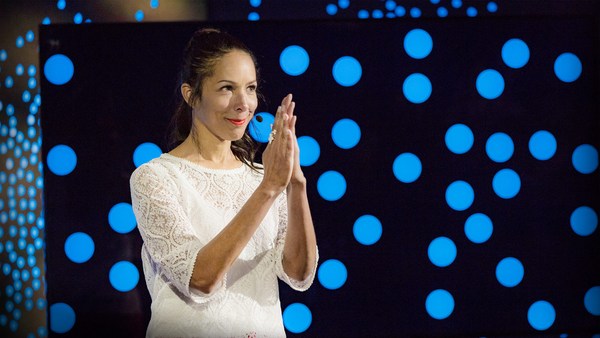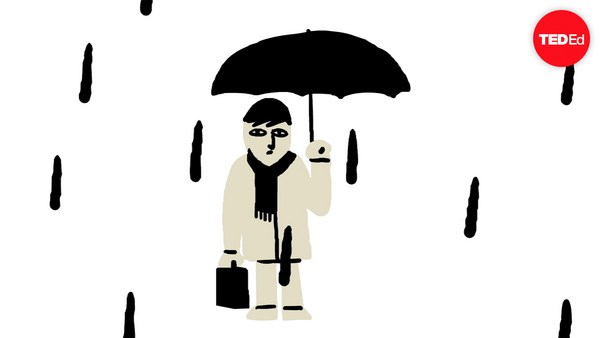So I vividly remember my first anxiety attack. It's kind of like I feel right now.
(Laughter)
Whoo, is it hot in here?
(Laughter)
It's hot in here.
(Laughter)
This wave of fear crashed over me, and my heart started to pound. My breathing got ahead of me and out of control. My face felt hot. It's hot in here, right?
(Laughter)
Yeah, it's hot. And I got doused in this really uncomfortable cold sweat. It was a life-changing moment, because I made a decision, right there and then, to dedicate my career to ridding our world of this feeling, anxiety.
So that was more than two decades ago. Work in progress.
(Laughter)
I became a clinical psychologist. I became a professor. I started an anxiety treatment center. And then, I realized, at some point along the way, that eradicating anxiety from our lives would not be beneficial.
Sometimes, anxiety interferes with your life. That's clinical anxiety. And yes, you do want to get rid of that clinical anxiety, with the help of a professional. But other times, many times ... it's uncomfortable, it's uncontrollable. Did I mention it's hot in here?
(Laughter)
It's intense. But that's a good thing. It's a good thing.
Many of the greatest leaders in human history, certainly in recent history, they were forged in a cauldron of anxiety. Once, early in his career, Sir Winston Churchill, he froze for three full minutes in the House of Commons, giving a speech. He fought against his phobia, faced his fears head-on, and he went on to become one of the greatest orators of the 20th century.
In the 1990s, after a box-office flop, Oprah Winfrey, she turned to food to drown out her feelings, to suppress her emotions. She ended up feeling emotionally numb for six weeks, and during that period of great anxiety, she learned the importance of letting go of her expectations for success. She went on to become a media icon.
And speaking of icons ... The first time Taylor Swift sang the national anthem at a football game, she felt paralyzed with fear. What she learned is to share her feelings with others. Listen to her lyrics. Many of them speak about her own anxiety. And now, well, apparently, she can “shake it off.”
(Laughter)
Anxiety is an emotion, like any other emotion, and it can do so much good for you. It can increase your resilience. It can strengthen your relationships. And it can help you to let go. When I first met Nicole ... she had hypochondriasis, which is clinical health anxiety. Despite numerous MRIs to the contrary, she was convinced that she had an aneurysm. Nicole's biggest fear was that her anxiety would spike, her brain would explode, and she would drop dead, which would not be good. Nicole started to withdraw from daily activities, and she recognized, rightfully, that she needed professional help, so she came in. Nicole overcame her obsessions with exposure therapy. She faced her fears. She embraced them head-on in order to build resilience. She read stories about aneurysms. She watched videos about aneurysms. She went to a local neurology ward. Nicole overcame her obsessions, and she graduated from therapy. I was so happy and so proud of her. And then, a couple years later, the phone rang. Nicole tells me she's pregnant with a baby boy, but the doctors told her that he would probably die because an ultrasound revealed that he had an aneurysm. Now given Nicole's history, I thought she would fall apart. But she didn't. She didn't. The baby needed life-saving surgery shortly after birth, and Nicole, understandably and very appropriately, was very anxious during the surgery, as the doctors operated. But she stuck with it, and so did he. Today, he is a healthy, thriving little boy, and also really cute, by the way. Really cute. Cute kid. And Nicole, she is a super-resilient mom because she faced anxiety. You are a lot more like Nicole than you think.
There have been many times in your life where you, too, embraced anxiety. When you embraced the discomfort, when you persevered, although you felt panicky and worried. And you've done this because, deep in your heart, you know that you cannot get rid of all of your anxiety, and it will always be uncomfortable. And that's why pushing against it creates mental muscle tone, which you need ... to crest over life's hurdles with grace. It can be difficult to love someone who has anxiety, and it's probably even more difficult to receive it. But deep human connection, deep emotional connections between people, requires vulnerability. So anxiety can be used to create intimacy.
Think about it. In your own life, who are the people who you feel closest to? Usually, it's those who you've opened up to about your anxiety in some way.
I myself -- This is going to be hard, but I'll try. I'm terrified of failure. I'm terrified of professional failure. And I struggle with vulnerability. In some ways, this propelled me and fueled my drive for professional success. But it created distance in my relationships. When I first met my wonderful, wonderful wife, Miri ... I put up a wall, and I didn't speak enough about my feelings, and I submerged my anxiety by focusing on my work. Right? Pretty classic, right?
(Laughter)
You don't need to be a psychotherapist to figure that one out.
(Laughter)
Of course, the feelings didn't go away. We all have this, like, chef, in the back of our emotional kitchen. Well, my chef cooked up these entrées of edginess, side orders of criticism and a whole bunch of other dishes that I'm not going to speak about in public.
(Laughter)
But Miri, thankfully, stuck with me. And more importantly, she consistently showed me that she would never judge me if I failed.
Eventually, I got the message. It took a while, but that unconditional love that I received allowed me to take the plunge, drop my guard, lower my defenses and identify what I was afraid of and to share it with her. I think it's the hardest thing I ever did my whole life. Definitely harder than anything in the professional realm. But there's nothing more worthwhile than taking our anxiety and turning it into love.
Losing control is utterly terrifying. It's terrifying. It's happened to everyone. But, but ... As long as you have a heads-up, as long as you expect it and you're a willing participant, doesn't it feel good to let go? You don't need to be a thrill-seeker to appreciate this. Adrenaline ... A shot of it comes with pure joy followed by this blissful tranquility, like, wow. And perhaps for that reason, even in this age of unprecedented, incredible anxiety, action and adventure movies, they make up more than 50 percent of box-office sales. And the most profitable genre of film is horror.
(Laughter)
It's funny.
(Laughter)
Now life isn't a movie, so it's very good to shape the world in accordance with your vision on a daily basis. It's very important that we do that. But, once in a while ... It's a human need to take a seat and go for a ride on the roller coaster of life, to let go.
(Laughter)
Doing so keeps your ego in check.
Some people view this surrender in spiritual terms. The Serenity Prayer, very commonly used to cope with anxiety, and it famously states "God, grant me the serenity to accept the things I cannot change." Now when you're ready -- not before you're ready, please, but when you're ready -- affirming the limits of your control ... it brings inner peace.
Anxiety is nothing to be ashamed of. We all have it. And it's not going away. Here are four steps that you can use to turn anxiety into your ally, not your enemy. But please, if anxiety interferes with your life, if it's clinical, don't just rely on this approach. Get the professional help you need. If we have an agreement on that, then I'll tell you the four steps.
(Laughter)
OK. Step number one -- identify. Many times, when you feel anxious, you squelch the sensations and push them out of your mind before you've even processed what you're worried about. Stop. Take a minute and ask yourself, "What am I truly afraid of?" Like what really is at the bottom of my fear? If you don't know the answer, that's fine. Go for a walk and don't come back until you have an answer.
(Laughter)
Step two -- share. Speak about your anxiety, with a friend, with a neighbor, with a coworker, with a stranger. I'm serious. If you're not ready for a conversation, that's fine. Text it. If it's more than a couple lines, sure. Email. Press send. Take the plunge. Be vulnerable.
Step three -- embrace. When you feel anxious -- not "if" -- you will. You will feel anxious. And when it happens, don't fight it. Don't squelch it. Let it happen, let it ride, let it ride. In fact, do things that make you uncomfortable. Intentionally. Repeatedly. As long as they're safe. That's how we build emotional resilience.
And finally, my favorite, four. Let go. Let go. Think back to step number one. What are you truly afraid of? And then, when you're ready, humbly admit, even for a moment, that you are not in full control of that outcome. It's scary to even think about, but it's not a bad thing. Firstly, sometimes challenges are a blessing in disguise, but either way, enjoy not being responsible for everything under the sun.
OK, should I try the four steps? Yeah, I'll give it a shot.
Identify. The hardest part about this talk was speaking about my anxiety in public. I was afraid you would judge me. It's really quiet in here. Did you judge me?
(Laughter)
OK. That made me really anxious.
(Laughter)
Share. OK, so I'm revealing this to you now because we've spent, like, 10 minutes together, and I've grown to like you. So I want more of an emotional connection here, and I hope it's mutual.
(Laughter)
OK, thanks.
(Cheers and applause)
(Exhales)
(Laughter)
Three -- embrace. Do you know what it's like to stand on this red dot and to speak about, like, all your issues in public?
(Laughter)
It's like diving off a cliff. Especially, remember that part about my emotional kitchen? Like, that was really vulnerable for me.
(Laughter)
And let go. So I'm sending this message about anxiety off into the universe. I hope that it will land on the hearts, minds and souls of a broader audience. But really, there's nothing I can do about that anymore.
(Laughter)
And that's OK. That's OK.
So please join me. What are the four steps? Let's say them together so we remember. (With the audience) Identify, share, embrace, let go.
Thank you very much.
(Applause)
